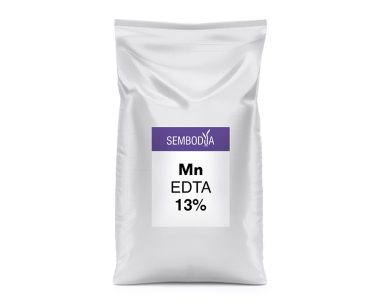- Manganese is particularly important for photosynthesis, supporting chlorophyll synthesis, respiration and cell division
- Provides for better nitrogen metabolism
- Contributes to better iron absorption
- Essential for the development of the root system
Mn EDTA 13 %
Application of manganese in chelated form (Mn EDTA 13%) is an affordable and effective way to correct manganese deficiency, especially in the most manganese-sensitive crops – wheat, soybean, sorghum, sugar beet. Chelates are complex compounds in which a metal ion is bound to an organic compound. This preserves its stability and ensures its uptake by plants.
Manganese is required in small amounts by plants (20 to 300 ppm), but like other trace elements it is as important to crop development as the macro nutrients.
Dose rate for foliar application: 500 – 1000 g/ha
Number of applications: 1 – 4
Timing/Conditions of application: Throughout the growing season. In most crops, the need for manganese increases during flowering and fruit formation, and decreases toward the end of the growing season.
Antagonism: Excessive presence of manganese leads to iron and zinc deficiency. Mn toxicity occurs in poorly drained or acid soils with higher manganese content.
Manganese deficiency most commonly occurs in soils with high organic matter content, in alkaline soils (with an excess of calcium in carbonate soils), and during drought.
Symptoms of manganese deficiency in various plant species are primarily expressed as spotted chlorosis on the leaves (gray speckling). Initially, individual light yellow, pinpoint spots or short interrupted streaks appear between the veins on the leaves, which then turn gray. In cases of severe manganese deficiency, these streaks merge along the length of the leaves into long uninterrupted streaks that gradually dry, turn brown, and form areas of dead tissue. The overall plant growth is retarded in the presence of severe deficiency.
- Manganese is particularly important for photosynthesis, supporting chlorophyll synthesis, respiration and cell division
- Provides for better nitrogen metabolism
- Contributes to better iron absorption
- Essential for the development of the root system
Dose rate for foliar application: 500 – 1000 g/ha
Number of applications: 1 – 4
Timing/Conditions of application: Throughout the growing season. In most crops, the need for manganese increases during flowering and fruit formation, and decreases toward the end of the growing season.
Antagonism: Excessive presence of manganese leads to iron and zinc deficiency. Mn toxicity occurs in poorly drained or acid soils with higher manganese content.
Manganese deficiency most commonly occurs in soils with high organic matter content, in alkaline soils (with an excess of calcium in carbonate soils), and during drought.
Symptoms of manganese deficiency in various plant species are primarily expressed as spotted chlorosis on the leaves (gray speckling). Initially, individual light yellow, pinpoint spots or short interrupted streaks appear between the veins on the leaves, which then turn gray. In cases of severe manganese deficiency, these streaks merge along the length of the leaves into long uninterrupted streaks that gradually dry, turn brown, and form areas of dead tissue. The overall plant growth is retarded in the presence of severe deficiency.





